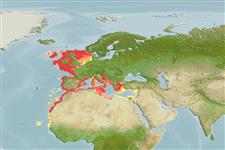Common names from other countries
Environment: milieu / climate zone / depth range / distribution range
Écologie
; profondeur 3 - 750 m (Ref. 113220). Subtropical; 60°N - 14°N, 25°W - 36°E
Distribution
Pays | Zones FAO | Écosystèmes | Occurrences | Introductions
Eastern Atlantic and the Mediterranean: Norway to Senegal and Cape Verde to Turkey.
Length at first maturity / Taille / Poids / Âge
Maturity: Lm ? range ? - ? cm Max length : 3.4 cm CW mâle / non sexé; (Ref. 244); 1.8 cm CW (female)
Epibenthic (Ref. 87524). Also on sandy bottom (Ref. 113220). Carnivorous (Ref. 112914). Benthophagous (feeding on the bottom) (Ref. 104429).
Life cycle and mating behavior
Maturité | Reproduction | Frai | Œufs | Fécondité | Larves
Members of the order Decapoda are mostly gonochoric. Mating behavior: Precopulatory courtship ritual is common (through olfactory and tactile cues); usually indirect sperm transfer.
Gusso, C.C., M.F. Gravina and F.R. Maggiore. 2001. (Ref. 2780)
Statut dans la liste rouge de l'IUCN (Ref. 130435)
statut CITES (Ref. 108899)
Not Evaluated
Not Evaluated
Utilisations par l'homme
Pêcheries: commercial
| FishSource | Sea Around Us
Outils
Sources Internet
Estimates based on models
Preferred temperature
(Ref.
115969): 6.3 - 14.8, mean 9.5 (based on 603 cells).
Catégorie de prix
Unknown.
